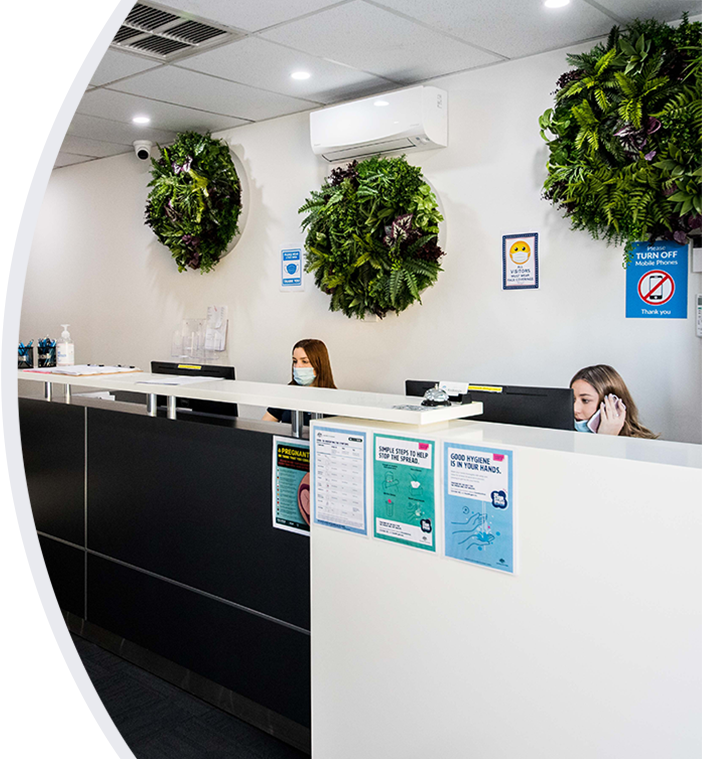Ultrasound
What is an Ultrasound?
An ultrasound is a safe, painless diagnostic imaging procedure that does not use radiation. Ultrasound utilises high frequency sound waves to produce real time diagnostic images of the soft tissues within the body. An ultrasound is performed using a hand held device called a transducer, which is moved across the body part of interest in order to acquire the images. The transducer transmits sound waves into the body and then they are reflected back to the transducer from the different tissues within the body. The ultrasound machine converts the reflected sound waves into an image of the body part being scanned.
Who performs an ultrasound?
An ultrasound is performed by a health professional called a sonographer. A sonographer is specially trained in performing ultrasounds and has a Bachelor or Graduate Diploma qualification as a minimum standard.
The images taken by the sonographer are reviewed by a radiologist (imaging specialist doctor) who will generate a report containing all of your results.
What happens during an ultrasound?
At the start of your ultrasound, the sonographer will welcome you into the ultrasound room and introduce themselves. They will confirm your details and ask you a few questions about the reason for your scan. The procedure will be explained to you and you will have the opportunity to ask questions if you have any. You will be asked to take a seat or lie down on the scanning bed and expose the area of the body to be scanned. A gown or sheet will be provided for privacy if required. A water based gel will be placed on the skin and the transducer will move over the skin while images are being acquired. You may be asked to perform different manoeuvres during your scan to improve the quality of the images. Such manoeuvres might include holding your breath or changing your position on the bed. An ultrasound is not a painful examination. If you experience any discomfort during your scan please inform the sonographer and they will make an attempt to make it more comfortable for you.
Occasionally the radiologist will also attend the examination. This enables them to view the images in real time. They may also ask questions about your symptoms.
How long does an ultrasound take?
The duration of an ultrasound depends on the body part being scanned. An ultrasound can take up to 30 minutes, however, in some instances, it may take longer depending on the complexity of the examination or the area that needs to be covered. You can confirm how long your ultrasound will take when you make your appointment.
Do I need an appointment for an ultrasound?
It is necessary to make an appointment for most ultrasounds and we will endeavour to find a time that is convenient for you.
There are some ultrasounds that are considered medically urgent. You do not require a booking for an ultrasound if your doctor has referred you for one of the following indications:
- Suspected deep or superficial vein thrombosis (DVT or SVT)
- Suspected ovarian torsion
- Suspected ectopic pregnancy
- Suspected testicular torsion
- Suspected acutely ischaemic limb
- Bleeding in pregnancy
If you have been referred for the above reasons, this is considered an urgent scan. Please contact your closest Vision Radiology clinic and we will accommodate your scan on the same day. Your results will be sent back to your doctor within an hour of the examination.
Why have I been referred for an ultrasound?
Ultrasound can be used for screening, diagnosis or to help plan treatment. Ultrasound is useful for assessing various soft tissues and organs within the body including:
- Muscles, tendons, ligaments and some peripheral nerves
- Superficial lumps
- Blood vessels and the blood flow within them
- Abdominal organs such as the liver, gallbladder, spleen and pancreas
- Pelvic organs such as the uterus and ovaries
- Urinary tract including the kidneys, bladder and prostate
- Superficial organs such as the thyroid, testicles and breast
Ultrasound can be used to help guide injections or to guide biopsies to the correct place.
Ultrasound can be performed at various stages during pregnancy. In the first trimester, ultrasounds can be performed to determine the gestational age, pregnancy location and viability. Ultrasounds to assess foetal anatomy can be performed at 13 weeks and 20 weeks gestation. Additional ultrasounds may be required in certain circumstances, as requested by your doctor.
Ultrasound is not able to image bone or lungs and has limited applications scanning bowel. This is because the ultrasound is unable to penetrate through bone or tissues that are filled with air.
How do I prepare for an ultrasound?
There some important things to remember when attending your ultrasound appointment:
- Bring your referral letter from your doctor
- Bring any previous ultrasound, x-ray, CT or MR results if they were performed at another location
- Wear comfortable clothing so that the area being imaged can be easily accessed by the sonographer. Leave jewellery and valuables at home
- Follow any instructions that you have been given by our staff, particular to the type of scan you are having performed.
- A list of specific ultrasound preparations can be found below.
Abdominal ultrasound
Please fast for six hours prior to your scan. This means no eating, chewing, drinking or smoking. Fasting improves the accuracy of the scan and minimises bowel gas that can obstruct the view of the organ being examined. Furthermore, fasting ensures that the gallbladder is fully distended and permits optimum visualisation.
If you need to take regular medications, you can do so with a small amount of water. Diabetics, please contact the clinic for specific instructions.
Renal ultrasound
You are required to attend with an uncomfortably full bladder.
One hour prior to your scan please empty your bladder, then drink 1 litre of water. Keep your bladder full and do not empty until after your scan. This allows optimum visualisation of your bladder and the surrounding structures.
Female pelvic ultrasound
You are required to attend with an uncomfortably full bladder.
One hour prior to your scan please empty your bladder, then drink 1 litre of water. Keep your bladder full and do not empty until after your scan. This allows optimum visualisation of your uterus, ovaries and the surrounding structures.
There are two ways a pelvic ultrasound can be performed: transabdominal (external) or transvaginal (internal). The two methods will be discussed in detail at your appointment and you have a choice about what is the appropriate method for you. There are certain situations where a transvaginal ultrasound will not be offered, for example in children, or where women may decide not to have one. Women are able to request a female sonographer to perform their scan and we ask that you inform our staff of your preference at the time you make your booking.
Transabdominal
A full bladder is essential. The ultrasound transducer is placed over the lower abdomen to image the uterus, ovaries and surrounding structures.
Transvaginal
This approach provides the most detailed view of the pelvic organs. It is done by inserting a long, narrow ultrasound transducer into the vagina. The transducer will be covered with a protective covering and lubricated with gel. The transducer is moved around gently whilst the images are being taken. Most women would not find a transvaginal ultrasound painful.
Verbal and written consent is obtained prior to commencing a transvaginal ultrasound. You will also be asked to empty your bladder before starting.
A transvaginal ultrasound is best performed on day 5-10 of the menstrual cycle, unless indicated otherwise.
Pregnancy ultrasound
There is no preparation required for pregnancy ultrasounds.
Dating ultrasounds are best performed from 6 weeks.
First trimester anatomy ultrasounds are best performed at 13 weeks.
Second trimester morphology ultrasounds are best performed at 20 weeks.
Ultrasounds may also be requested at other stages throughout your pregnancy to monitor progress or screen for complications. Your doctor will provide you with individual advice according to your circumstances.
Vascular ultrasound, including aorta, leg arteries and renal arteries
Please fast for six hours prior to the scan. This means nothing to eat until after the scan is complete. The reason for this is to minimise the amount of gas in the bowel that can obscure the view of the blood vessels being imaged. A small amount of water is ok.
Interventional ultrasound
If you are having an injection, biopsy or fine needle aspiration under ultrasound guidance you will be given instructions specific to your intervention when you make your appointment. Please contact our reception staff if you have any questions about your procedure.
Other ultrasounds including musculoskeletal, breast, thyroid and testicular
There is no preparation required.
Paediatric ultrasounds
Please contact us for special instructions to ensure that your child’s ultrasound is performed in an age appropriate manner.
What are the risks of having an Ultrasound?
There are no risks associated with an ultrasound examination. It is a simple and safe test.
Where do I get my results?
Our radiologists (imaging specialist doctor) will view your images and write a report as soon as possible. Reports are sent to your referring doctor and are available within 48 hours. Make an appointment with your referring doctor to discuss the results of your scan.

We offer accessible services by bulk billing almost all examinations and procedures. To find out more, visit our billing information page.
Complete our booking form and one of our friendly staff will contact you – it’s quick, and easy. Click on the below link and follow the simple steps. Remember to have your referral handy.


















